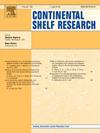从麦肯齐河三角洲到北冰洋深海的稀土元素分布及其特征
IF 2.2
3区 地球科学
Q2 OCEANOGRAPHY
引用次数: 0
摘要
麦肯齐河是北美向北冰洋提供淡水和沉积物最多的河流。在这里,我们评估了稀土元素(REE)作为其沉积物来源和命运的示踪剂的潜力,从河口到北冰洋深处。从三角洲到海洋陆架、斜坡和盆地共采集了21个地点的沉积物岩心,测量了总REE、淋溶REE和残余REE浓度的空间分布和岩心下分布。结果表明,三角洲地区稀土元素浸出比例最高。这一比例随着距离河流的距离而减小,表明与其他沉积物源混合,REE损失到残余相,或通过吸附和络合作用在沿海水域中清除REE。按原子序数绘制的标准化稀土浓度提供了区域特征。浸出的稀土元素特征表明,麦肯齐三角洲中稀土元素富集,随着离三角洲距离的增加,富集程度逐渐降低。然后,我们使用相似指数(SI)来研究稀土元素特征之间的差异,并以河流和深海盆地值作为计算端点。我们的研究结果突出了麦肯齐地区沉积物对波弗特海边缘的影响。总的来说,我们的研究结果表明,稀土元素是识别沉积物来源的相关示踪剂,追踪从三角洲到北冰洋深处的稀土元素分布为沉积物运输机制提供了额外的见解。本文章由计算机程序翻译,如有差异,请以英文原文为准。
Distribution of rare earth elements and their signatures from the Mackenzie River delta to the abyssal Arctic Ocean
The Mackenzie River is North America's largest contributor of freshwater and sediment to the Arctic Ocean. Here, we evaluate the potential of rare earth elements (REE) as tracers of its sediment sources and fate, from the river mouth to the deep Arctic Ocean. We collected sediment cores from 21 sites, from the delta to the marine shelves, slopes and basins and measured the spatial and down-core distribution of total, leached and residual REE concentrations. Our results show that the proportion of leached REE is highest in the delta. This proportion decreases with distance from the river, suggesting mixing with other sediment sources, REE loss to the residual phase, or REE scavenging via adsorption and complexation in coastal waters. Normalized REE concentrations plotted against their atomic number provide regional signatures. The leached REE signatures indicate medium REE enrichment in the Mackenzie Delta, an enrichment that diminishes with distance from the delta. We then used a similarity index (SI) to investigate the divergence amongst REE signatures, with riverine and deep marine basin values as endmembers for the calculation. Our results highlight the influence of the Mackenzie Region sediments on the Beaufort Sea margin. Overall, our findings demonstrate that REE are relevant tracers for identifying sediment sources and that tracking REE distribution from the delta to the deep Arctic Ocean offers additional insights into sediment transport mechanisms.
求助全文
通过发布文献求助,成功后即可免费获取论文全文。
去求助
来源期刊

Continental Shelf Research
地学-海洋学
CiteScore
4.30
自引率
4.30%
发文量
136
审稿时长
6.1 months
期刊介绍:
Continental Shelf Research publishes articles dealing with the biological, chemical, geological and physical oceanography of the shallow marine environment, from coastal and estuarine waters out to the shelf break. The continental shelf is a critical environment within the land-ocean continuum, and many processes, functions and problems in the continental shelf are driven by terrestrial inputs transported through the rivers and estuaries to the coastal and continental shelf areas. Manuscripts that deal with these topics must make a clear link to the continental shelf. Examples of research areas include:
Physical sedimentology and geomorphology
Geochemistry of the coastal ocean (inorganic and organic)
Marine environment and anthropogenic effects
Interaction of physical dynamics with natural and manmade shoreline features
Benthic, phytoplankton and zooplankton ecology
Coastal water and sediment quality, and ecosystem health
Benthic-pelagic coupling (physical and biogeochemical)
Interactions between physical dynamics (waves, currents, mixing, etc.) and biogeochemical cycles
Estuarine, coastal and shelf sea modelling and process studies.
 求助内容:
求助内容: 应助结果提醒方式:
应助结果提醒方式:


